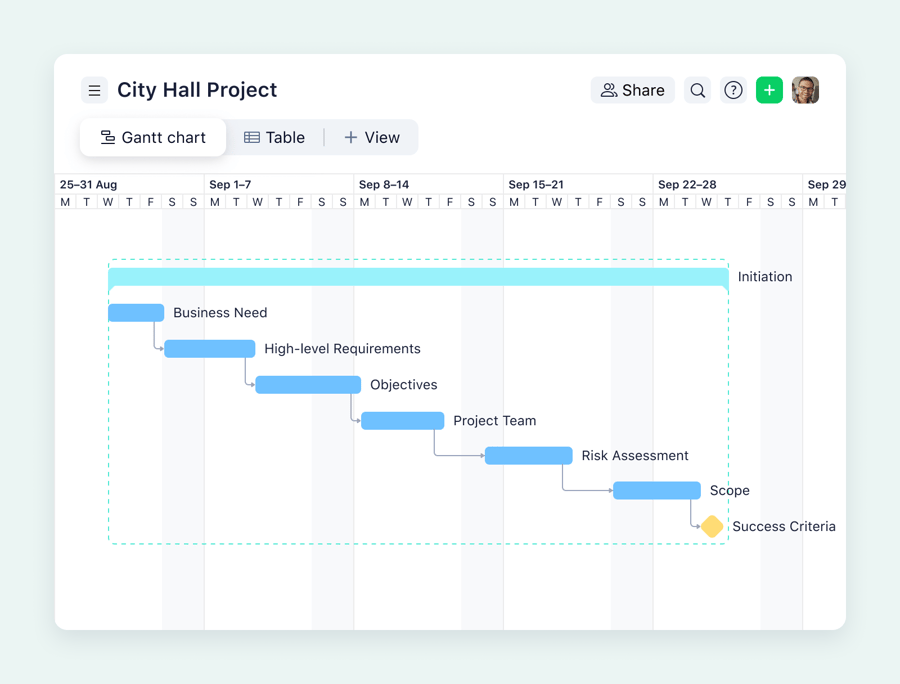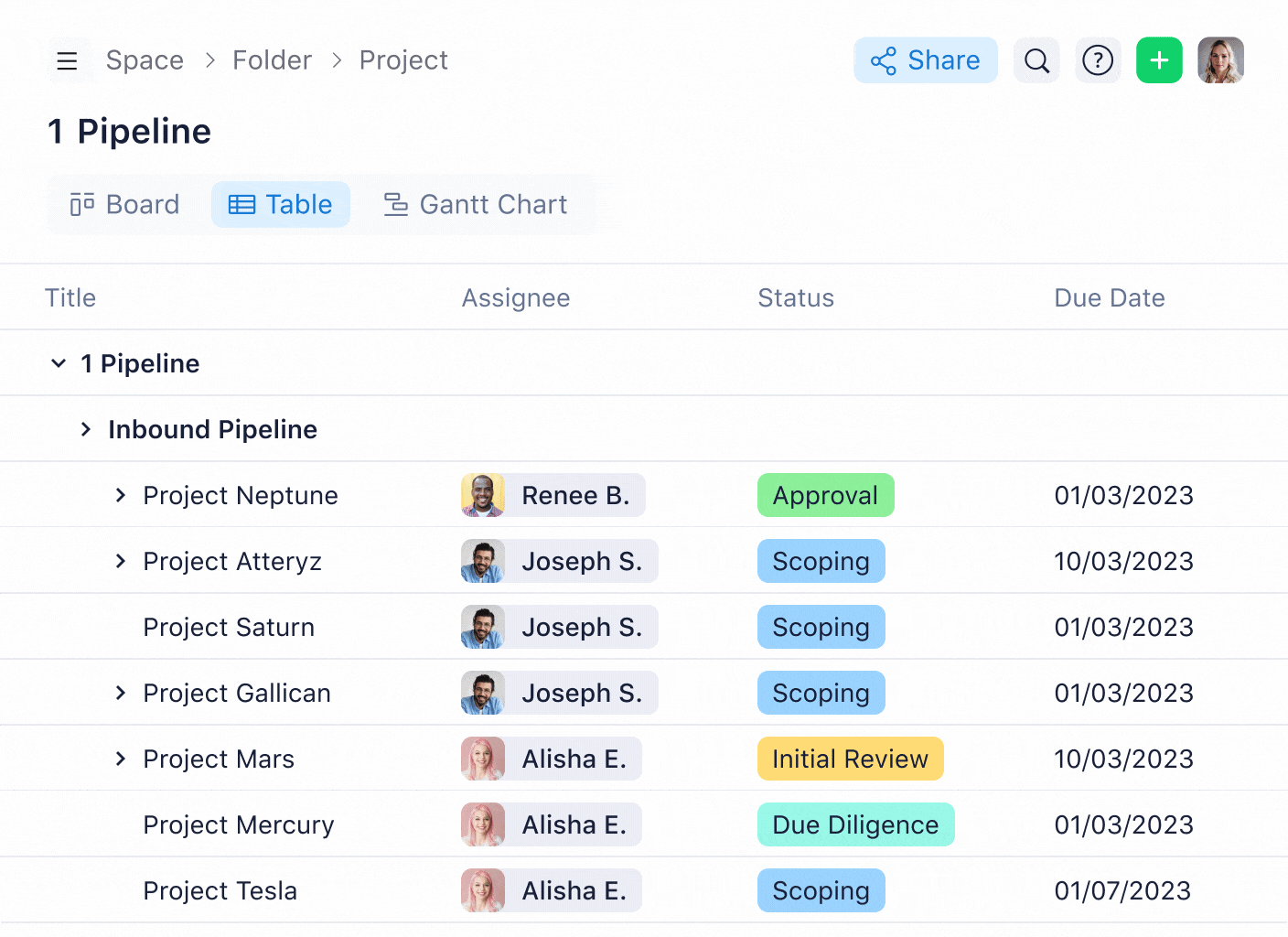With any business venture, you need to create a compelling case for your new product or service’s ability to solve a particular problem. Before you can persuade the customers to pay, there needs to be concrete evidence that you can offer the solution.
A proof of concept (POC) provides just that: evidence that your ideas can come to fruition and work in a practical sense.
By developing a proof of concept, you can also gather key insights from team members and users alike, which can shape the product or software development process.
Once you have a proof of concept in place, you can enter the development phase and effectively monitor progress with a project management solution such as Wrike.
Proof of concept definition
What is a proof of concept (POC)?
The proof of concept meaning is simple: It’s a way of demonstrating the viability of an idea or concept. Its application extends beyond physical products and into the development of technology or software.
In the project management process, you can view the proof of concept as a green light indicating you’re ready to progress into the product development phase.
The idea behind drawing up a POC is to test a new idea or concept before you’ve heavily invested resources into one solution or another. It can help you feel more confident that what you’re making or developing will indeed solve the problem or customer pain point you’re targeting.
When you have an idea of what a product or service will be like, you can invite feedback from team members, users, and stakeholders that can then be incorporated into your development process.
What’s in a proof of concept?
In any proof of concept, you would have:
- A clear objective: Without a clear idea of the purpose of the product, you won’t know whether it’s capable of solving a particular problem.
- Product specifications: A general overview of the features and functions you’ll test will help guide your proof of concept process.
- A demonstration: Some form of a working prototype that demonstrates the product or software’s capabilities will serve as evidence that you’re good to go ahead.
- Evaluation: Define what success looks like and what data you can collect during the process.
What are proofs of concept used for?
There are many use cases for the proof of concept, such as the following:
- Introducing technology: Investing in new tech and software solutions can be costly, especially if you make the wrong choice. That’s why a POC can prove useful as you can put the tech to the test before full implementation.
- Refining processes: You can use a POC to refine existing processes by trialing new solutions such as automation or AI features.
- Developing products: One of the most common use cases for a POC, you can streamline the product development process by putting ideas and concepts to the test before entering the manufacturing stage.
When you commit to creating a POC, you safeguard yourself against potential problems by anticipating them in advance. This means you can set a project budget confidently, without fearing that the end product won’t serve its intended purpose.
You can also create alignment with broader strategic goals within the company, as you invite input from all parties so everyone with a vested interest in the project can give their approval before you start work.
How long should a proof of concept be?
The length of a proof of concept will vary according to the team and the scope of the project. Since each POC process is unique, there’s no universally agreed-upon time frame for completing one.
If, for example, you’re in an enterprise that wants to trial Amazon Web Services to scale with cloud-based infrastructure, you might look to run a department-wide proof of concept.
During this POC process, you would run several stress tests and get to grips with the features and functions to see if they align with your strategic goals. This process could take several hours or days, depending on how thoroughly you test the solution and what you need it for.
Don’t underestimate the power of an effective proof of concept. Validate your business idea and bring it to life with Wrike.
6 steps to write a successful proof of concept
Now let’s discuss the step-by-step process for putting pen to paper and explore how to write a POC for a product or project idea.
1. Demonstrate the need for the project or product
The first step in creating a proof of concept should be to identify the problem or customer pain points that the project or product will solve. Creating a customer experience strategy will help you pinpoint what direction you need to go in with your project.
If it’s an internal tool to streamline productivity, is there data to suggest there’s an opportunity to improve performance levels?
If it’s a customer-facing software solution feature, is there evidence from your market research or customer feedback that implies your product idea would go down well?
Without some form of evidence to back up the need for the project or product, the proof of concept is irrelevant, as you’re testing an idea that likely won’t land favorably in the eyes of the target audience.
2. Create a roadmap for the solution
Next, develop a roadmap for the proposed solution that gives you a blueprint for execution.
The proof of concept should just be one small cog in the larger wheel of the product development process, so use this opportunity to plot out the entire roadmap for the product or project.
Detail what purpose it will serve and whose lives it might improve. Include all the technical details such as specifications, functions, and features. Also, map out how you’ll bring the product or project to life, be it through project management software, a manufacturing process, or another method.
3. Develop a prototype
Once you have a roadmap in place, you have a starting point.
From here, you can develop a working model — in the form of a prototype — that tests your theories about the project or product in order to prove feasibility.
The prototype can be a watered-down version of an end product, a small-scale version of a software solution, or anything else that allows you to test your ideas and put them into practice.
4. Test the prototype
When you’ve built your prototype, you’ve proved that it can exist in some form. Now, you need to stress-test it and put it through its paces to accurately examine viability.
The product development team can carry out thorough testing of the prototype according to the success criteria they developed and constantly refer back to its intended purpose. You can also bring in team members from other departments or a relavant stakeholder to get different perspectives and suggestions for changes.
5. Gather results and feedback
In this stage of the POC process, your primary goal is to review the data you’ve collected and see whether it satisfies your success criteria.
Let’s say you work for a coffee machine manufacturer and you’re testing a new type of machine that keeps coffee hot for an hour after brewing. With your POC prototype, you could run several experiments with different types of mugs and settings to see if you can hit the sweet spot of remaining hot for 60 minutes after the brewing process is over.
If the coffee were to remain hot after brewing but only for 30 minutes, this would fall short of your initial success criteria. From here, you might decide to revisit the ideation stage or shift your marketing to align with the altered vision for your coffee maker.
6. Present the proof of concept for approval
The final stage of the process will often be presenting your proof of concept for approval.
This is where you’ll submit your findings to see whether you have the green light to go ahead with developing the final product or project.
Provided your POC satisfies the initial success criteria — which were unanimously decided — you should have no issue getting the approval you’re looking for. If you use a project management solution such as Wrike, getting approval for a POC document is as simple as passing it on to the right person who can then examine and approve it directly in the software.
Proof of concept examples
Calling all project managers and development teams! Sometimes, it helps to see real-life examples to fully understand a process, which is why we’ve put together these three examples to help you visualize what it could look like for you and your team.
Proof of concept in software development
In software development, one of the biggest advancements in recent years has been machine learning (ML). With ML, software developers can leverage artificial intelligence to automate core tasks or predict behaviors to provide solutions to emerging problems.
However, there are many ML models around, so it can be difficult to know which might best improve your software development process.
With a POC, you can try out various models to see if they satisfy your success criteria and help you iron out bottlenecks or other issues in the software development pipeline. By feeding the ML model a smaller dataset, you can analyze the results and see how much of an impact it could have on a larger scale.
Proof of concept in business development
In business, it can be hard to ascertain whether an idea you have to grow your business will fly or flop.
Say you have an idea for a grocery delivery business that involves having shoppers gather the groceries, and delivery drivers take them to the buyers’ homes. To test this model before investing significant resources into it, you could try servicing a small area first to test viability.
During this proof of concept, you would be able to test elements such as delivery speed and how well the app or website works for customers, and gather valuable user feedback. You could also find out if you’re entering an overcrowded market or whether there’s a healthy demand for the service.

Proof of concept in project management
Project management refers to how you complete and monitor tasks and projects accommodating your team members and the clients you serve.
Most companies use some form of project tracking software to simplify the process, but there are also various methodologies to consider. For instance, you may find the idea of using Agile Kanban boards intriguing but, without any hard evidence of their effectiveness, it could be a risk to implement them.
Using a POC process, you can easily put your theory to the test and trial Kanban boards for one team or division. From there, you can evaluate how well it works, whether team members take to it, and analyze the results.
Wrike is here for your team
So, now you know how to write a proof of concept. Still, proofs of concept can be challenging to navigate without a clear metric tracker or system in place for sharing ideas, documents, and data with your team and stakeholders.
With Wrike’s business goals tracker, it’s easy to exchange information during the POC process and seek approval at every stage from key internal and external stakeholders.
Here are a few ways you can use Wrike’s project resource management features to assist the POC process:
- Approvals: Automatically share approval requests inside and outside of your team to get the green light and fast-track progress.
- Cross-tagging: Tag team members and those in other departments when you need outside input or assistance with the POC process.
- Automation: Set up automation rules that you can trigger with certain tasks and actions to streamline the POC process.
You can also use the Wrike action plan template to get the ball rolling on your project.





